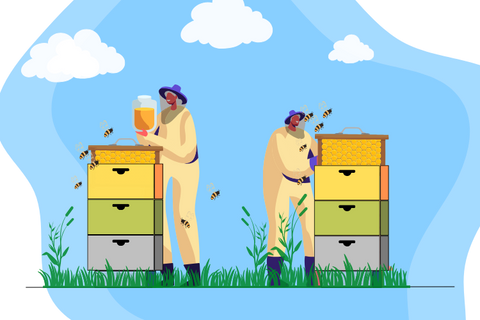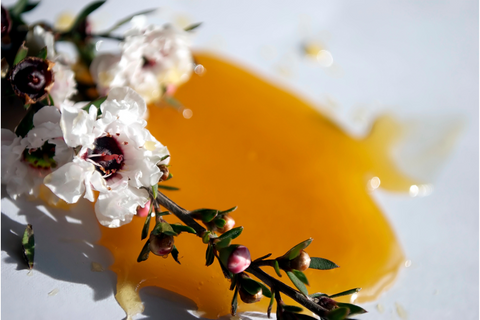As with so many other things, a successful beekeeping career starts with the right preparation. Before you dive in and buy your first colony of bees, you should have some basic equipment at hand. This is your guide to the most important beekeeping beginners’ equipment.
The Suit
For beginners, we always recommend a full suit rather than just a jacket or a veil. The suit provides the maximum amount of protection and will give you the confidence you need to handle your bees responsibly. Minimizing the risk of getting stung will be a huge advantage, especially in the beginning, when your body is not used to it.
You can get ventilated suits that will help dissipate body heat and perspiration. The cooling effect which is thus created helps you regulate your body temperature even on hot summer days. However, for this system to work, you need to keep bees in an environment with constant movement of air. These suits are not suited for use in mostly windless areas.
Of course, you can also get a jacket and veil. They will allow you to pay your bees a quick visit when you don’t feel like donning the entire suit.
Whatever option you are going for, just remember: You don’t want to win any fashion competitions with your beekeeping outfit. What is really important is that you feel comfortable, you can move around freely and easily and have the protection that makes you feel most confident around your striped, little friends.
Beekeeping Gloves
Of course, both the gloves and suit are meant to protect you from stings. So, you should ask yourself, “How much protection do I want from my gloves?”
The main decision you need to make concerns the material. Most beekeeping gloves are either made of leather or nitrile.
Leather gloves:
|
Pros |
Cons |
|
High level of protection
|
Difficult to feel the bees
|
|
Security
|
More likely to crush or crowd them
|
|
Confidence
|
Makes bees more alert and likely to sting
|
Nitrile Gloves:
|
Pros |
Cons |
|
Better sensitivity |
One-use (less sustainable) |
|
Allow for more nimble handling |
Offer less protection |
|
Less likely to hurt the bees |
|
The Beehive
An internationally used and easy-to-build hive is the Langstroth hive. Most countries around the world are familiar with some type of Langstroth hive. Therefore, the production of this type of hive is more standardized and cheaper than that of others.
Even for beginners, a Langstroth hive is quite easy to assemble and not much can go wrong. On top of that, the frames are pretty sturdy and allow for easy handling when you want to inspect your bees. Additionally, the Langstroth system is perfectly suited for expanding your beehive. You can keep adding elements and grow your colony. This makes them an ideal entry-level type of hive.

Beekeeping Essentials
Hive tool: Every beekeeper needs a hive tool. This allrounder is handy in several situations. You will use it to open your hive, shift frames or scrape the wax. There are numerous variations of this tool. Eventually, you are going to find out which one suits you and your needs best. However, since they are rather cheap you may as well get a handful of different tools right at the beginning.
A smoker: The smoker is a very useful tool for inspecting your bees. You use it to smoke your frames and “lull” your bees into a calm, less alert state. This will allow you to work on your frames, inspect your bees and handle them with a reduced risk of stings.
Bee Brush: Use a bee brush to gently get your bees to leave a frame when you are working on it. This method is much more bee-friendly than pushing them off with your gloved hands and will make sure you don’t hurt them.
Get Ready for Your Honey!
Now that you have all the equipment you need to handle your beehive successfully, it’s time to think about extracting honey from your colony. There are different types of honey extractors and each has advantages and disadvantages depending on your specific case.
First, let’s look at how the honey extractors are operated. We distinguish between two types of operational systems: manual and motorized. The main difference should be rather self-explanatory.
Manual Extractors: These extractors are a great choice for beekeepers who like to put in some work! They are operated via a crank at the top of the container. They are much cheaper than motorized models. In many cases, manual extractors come with removable legs and are, therefore, easier to set up and offer more flexibility in terms of storage.
Motorized Extractors: The motorization allows for more efficient extraction and gives you the time to focus on other tasks while the machine is doing the work for you. Since you can control the speed of motorized extractors, it is easier to extract different types of foundations. Frames with a plastic foundation, for example, can be spun at a higher speed than those with a wax foundation.

Apart from the way of operation, extractors are also different in how their interiors are constructed. The frames are either placed in the extractor like the spokes of a wheel (radial) or along the sides of the extractor (tangential).
Again, each model offers different advantages. In a tangential extractor, the honey is spun from the frames one side at a time. That means you will have to turn the frames halfway through the process. Though this adds a step to the workflow, it also means that the honey is extracted more thoroughly. You can get tangential extractors as both motorized and manual models. For beginners who only manage a few colonies, a motorized tangential extractor is an excellent choice.
Radial extractors are more efficient for beekeepers with a larger number of colonies. Here, the honey is extracted from both sides of the frames simultaneously. Therefore, the extraction process is quicker and easier. The extractors come in different styles and sizes. Whether you want one that can fit 6 or 20 frames at a time is completely up to you.
Honey Jars & Labels
Once you have extracted your honey, you need something to fill it in. So, make sure to buy enough honey jars before you start extracting. Think about how many jars you want to fill and choose the sizes accordingly. Some standard sizes are 8 oz, 16 oz or 24 oz jars.
The shape and size of your honey jars will also determine the kind of label you need. At us.honeysticker.com you have the choice between a variety of different honey labels. You can get ovoid, rectangular, round or hexagonal labels – to name only a few.
The Basic Equipment for Every Beekeeper – Summary:
|
Suit |
Gloves |
|
Bee Hive |
Hive Tool |
|
Smoker |
Bee Brush |
|
Extractor |
Jars |
|
Labels |
Last but not least: Bees |
And don’t Forget…
Although this article suggests that beekeeping initially is a lot of work and requires a fair amount of preparation you shouldn’t get discouraged. Keeping bees can be one of the most fulfilling activities you will ever pursue. So, do your research, get the right equipment and don’t forget to have fun!
Bibliography:
Bäckmo, Hanna. “Bee Suit – a Buying Guide.” Hanna’s Bees, 12 Feb. 2022, hannasbees.ie/bee-suit-a-buying-guide/.
“Bee Jackets versus Full Suits: Which Is Best?” Bee Clothing, www.betterbee.com/instructions-and-resources/bee-clothing.asp#:~:text=The%20ventilated%20fabric%20is%20designed,not%20be%20the%20best%20choice. Accessed 3 Feb. 2025.
Black Mountain Honey. “What Is The Best Beehive - Which Beehive System Is Best - Langstroth Versus National.” YouTube, YouTube, 30 Dec. 2021, www.youtube.com/watch?v=88OD8reiF58.
“Equipment Choices for Beginner Beekeepers.” PerfectBee, www.perfectbee.com/blog/equipment-choices-for-beginner-beekeepers. Accessed 3 Feb. 2025.
“Honey Extractor Types and Their Differences.” Beekeeping Supplies & Equipment | Dadant & Sons 1863, 28 June 2022, www.dadant.com/learn/honey-extractor-types-and-their-differences/.
“What Is a Hive Tool, and How to Use It.” Betterbee, www.betterbee.com/instructions-and-resources/hive-tools.asp?srsltid=AfmBOoqLGZ6T3x1bkSpY1k4wSktSK81DPc2QSZIlyH_ffs_bLCJAuG0n. Accessed 3 Feb. 2025.
“What’s the Best Kind of Beekeeping Gloves?” Betterbee, www.betterbee.com/instructions-and-resources/best-beekeeping-gloves.asp#:~:text=Most%20people%20start%20beekeeping%20wearing,ventilated%20and%20non%2Dventilated%20styles. Accessed 3 Feb. 2025.











